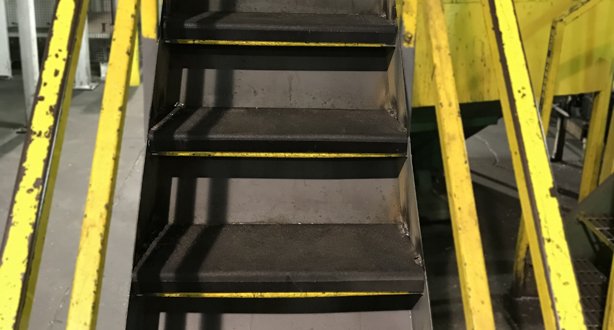Slip and fall accidents can result in injuries that can hinder performance on the job. Proper preventative measures on stairways can reduce these slip and fall accidents. Installing a SLIPNOT slip resistant steel stair nosing can aide in reducing workplace injuries in places where wet and oily conditions occur.
According to the informational booklet “Slips, Trips and Fall Prevention for Healthcare Workers” published by the Department of Health and Human Services, the Center for Disease Control, and the National Institute for Occupational Safety and Health, one of the top causes of slips, trips and falls is stairs and handrails that are improperly constructed. You can take these steps to make sure your each step and steel stair nosing are properly maintained and in good shape for everyone to walk on.
- Look for hazards
- Proper construction and maintenance of stairs and handrails (described in ANSI 2007, NFPA 2002) can reduce hazards. Stairs that are poorly marked or uneven, as well as handrails that are not of the appropriate size, height, or are poorly maintained can lead to missteps and can cause employees to trip and fall.
- Review where hazards occur
- The hazard can occur in many different areas. The top areas are as follows:
-
- Indoor and outdoor stairways
- Steps inside classrooms and conference rooms
- Elevated and/or sloping walkways
- Parking Structures
- Ramps
-
- The hazard can occur in many different areas. The top areas are as follows:
- Form prevention strategies
- Prevention is key in slip and fall accidents. If you can take the proper precautions on indoor and outdoor stairways, you can greatly reduce the number of slip and fall accidents. Listed below are just a few of the many tips on protecting yourself from slip and fall incidents on stairways.
- Did you paint or highlight the edge of the nosing to bring it to the attention of the person walking down the stairs?
- Making sure both the top and bottom are noticeable alert the person walking to a change in the elevation. For a steel stair nosing, it must be painted or galvanized to protect it from rust and corrosion.
- Did you check to see if the stair treads and nosing are slip resistant and extend the whole tread?
- This is vital when using a steel stair nosing. If the steel stair nosing is outside, you must make sure it is slip resistant and protected from the elements.
- Did you ensure that stairs are kept free of ice, snow, water, and other slippery contaminants?
- A SLIPNOT steel stair nosing can retain its slip resistance when completely submerged in oil, water, or other lubricants.
- Did you check that each stairwell has enough lighting to allow workers to walk safely?
- Do the stairways need a handrail? If so, are they the proper height?
- Consider adding a handrail at locations that have less than 4 steps (such as building entrances, short stairways from offices, plant equipment platforms, etc.)
- Confirm all handrails are within an appropriate height range (34–38″ from the stepping surface)
Taking proper precautions on stairways ensure the safety and security of workers. A SLIPNOT non slip nosing can aide in preventing slip and fall accidents on stairways.
Checklist is based on the booklet “Slips, Trips and Fall Prevention for Healthcare Workers” published by the Department of Health and Human Services, the Center for Disease Control, and the National Institute for Occupational Safety and Health.

